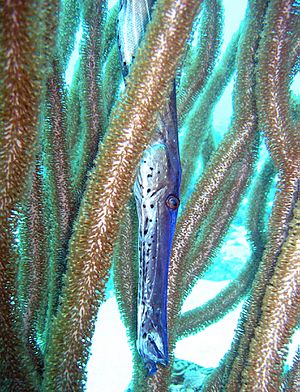Syngnathiformes facts for kids
Quick facts for kids Syngnathiformes |
|
|---|---|
 |
|
| Trumpetfish (Aulostomus maculatus: Aulostomidae), head in natural pose | |
| Scientific classification |
|
| Kingdom: | Animalia |
| Phylum: | Chordata |
| Class: | Actinopterygii |
| (unranked): | Acanthomorpha |
| Superorder: | Acanthopterygii |
| Clade: | Percomorpha |
| Order: | Syngnathiformes |
| Type species | |
| Syngnathus acus Linnaeus, 1758
|
|
| Families | |
|
See text |
|
The Syngnathiformes are a group of ray-finned fishes. This group includes amazing creatures like pipefishes and seahorses.
These fish have long, thin bodies. They are covered in bony rings, almost like armor! They also have tiny, tube-shaped mouths. Their special mouths help them suck up small prey from nearby. Many Syngnathiformes live in seaweed forests. They often swim straight up and down to hide among the plant stems.
One very special thing about these fish is how they have babies. Unlike most animals, the male fish are the ones who carry and protect the eggs! They keep the eggs in a special pouch or stuck to their tail until the babies are ready to hatch.
The name Syngnathiformes means "conjoined-jaws." It comes from Ancient Greek words: syn (meaning "together") and gnathos (meaning "jaw"). The ending "-formes" is from Latin and means "of similar form."
What are Syngnathiformes?
Scientists group living things into different categories. The Syngnathiformes are an "order" of fish. This means they share many common features.
Some scientists used to think these fish belonged to a larger group called Gasterosteiformes. This group includes sticklebacks. But now, most evidence shows that Syngnathiformes are their own separate order. They might not even be very closely related to sticklebacks.
Families of Syngnathiformes
The Syngnathiformes order includes several interesting families of fish. Here are some of the main groups:
- Seamoths (Pegasidae): These fish have flat bodies and wide, wing-like fins.
- Ghost Pipefishes (Solenostomidae): They look a lot like pipefishes but are often more colorful.
- Pipefishes and Seahorses (Syngnathidae):
- Pipefishes (Syngnathinae): These are long, thin fish that look like straight pipes.
- Seahorses (Hippocampinae): Famous for their horse-like heads and curly tails.
- Trumpetfishes (Aulostomidae): These fish have long, thin bodies and a trumpet-shaped mouth.
- Cornetfishes (Fistularidae): They are very long and slender, with a long, thin snout.
- Snipefishes (Macroramphosidae): These fish have very long, needle-like snouts.
- Shrimpfishes (Centriscidae): They are small fish that often swim head-down.
- Flying Gurnards (Dactylopteridae): These fish have huge, colorful pectoral fins that look like wings.
Some scientists have a slightly different way of grouping these fish. They suggest there are two main "clades" or branches:
- "Long-snouted clade": This group includes ghost pipefishes, pipefishes, seahorses, trumpetfishes, cornetfishes, and shrimpfishes.
- "Benthic clade": This group includes dragonets, slope dragonets, goatfishes, flying gurnards, and seamoths. "Benthic" means they live on or near the bottom of the ocean.
Scientists have studied the DNA of these fish. They found that many of these groups developed very quickly a long time ago. This is called a "rapid radiation."
Ancient Syngnathiformes
Scientists have found fossils of ancient Syngnathiformes. The oldest known one is a type of snipefish called Gasteroramphosus zuppichini. It lived during the late Cretaceous period, which was a very long time ago! This fossil looks similar to modern snipefish. It also has some features that suggest it might be related to the Gasterosteiformes group.
See also
 In Spanish: Singnatiformes para niños
In Spanish: Singnatiformes para niños

